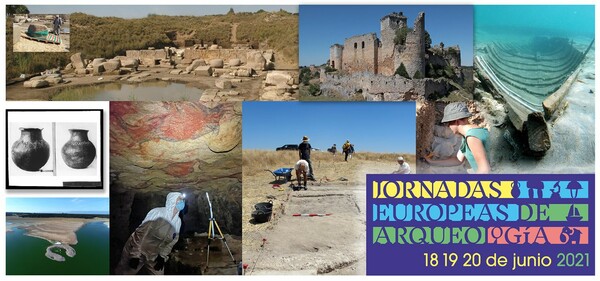Trailer JNA 2019
The Archaeology Days event across Europe:

© Ministry of Culture and Sports, Government of Spain
Since 2010, the French Ministry of Culture has placed the co-ordination and promotion of France’s National Archaeology Days (JNA) in the hands of the National Institute for Preventive Archaeological Research (Inrap).
These three days will be used to raise awareness and familiarize European audiences with all aspects of archaeology. A range of original and festive events will be organized, to allow families, schools, students, history enthusiasts or the merely curious to discover their archaeological heritage. Visits to places that are not normally open to the public (excavation sites, research centers, archaeological collections, etc.), meetings with archaeological professionals (archaeologists, researchers, etc.), who will be describing their profession to the public, along with a range of entertaining and educational activities (an introduction to excavation, demonstrations, workshops, etc.), are just some of the wide variety of programs available at the European Archaeology Days.
The JNA expanded to Europe in 2019. For the first time, seventeen countries participated.
In 2020, France's National Archaeology Days became the European Archaeology Days.
In light of the COVID-19 epidemic , the 11th edition of the European Archaeology Days (EAD) did not take place in its traditional form. Nevertheless, to celebrate archaeology with all publics, Inrap launched, under the aegis of the Ministry of Culture, the event #Archeorama. In addition to events with the public when the health situation permitted, the #archeorama event opened up the possibility of creating digital events and enhancing online resources: live meetings of archaeologists on social networks, publication of new videos, live lectures, virtual tours of exhibitions, 3D modelling of archaeological objects and sites, etc.
With more than 1,400 initiatives in Europe and 26 European countries participating, the 2021 European Archaeological Days were a tremendous success! Europe’s countries came out in full force for this year’s event, once again, offering more than 830 initiatives, signing the success of these days. More than 570 events took place all over France: excavation sites exceptionally opened to the public, educational and fun activities, archaeology villages, meetings with researchers, visits to laboratories, exhibitions, screenings... Throughout the three days, the public had the opportunity to take in an abundant programme offered by all those who make archaeology today.
The "#ArchaeologyBehindtheCurtain” operation was a resounding success, with 32 new events all over France, giving the public the chance to experience places or collections that are usually off-limits: museum reserves, behind-the-scenes exhibitions or laboratories, creative workshops, museums in the making, and more.
Video: an introduction to ceramology workshop for schoolchildren; children dig up ceramic shards that need to be reassembled in order to discover an object.
National Institute of Preventive Archaeological Research (Inrap):
Created by the 2001 law on preventive archaeology, the National Institute of Preventive Archaeological Research (Inrap) is the only competent public operator allowed to work throughout the country and across all periods, from Prehistory to the present day.
With thirty years of experience, they are involved on all types of sites: urban, rural, underwater, major transport and energy projects (roads, railways lines, etc.). Its role is to safeguard elements of France’s archaeological heritage affected by infrastructural development by studying them.
As a national research institute, it carries out some 1,800 archaeological surveys and 250 excavations each year in partnership with private and public developers in mainland France and overseas. At the end of the work, Inrap is responsible for the use and dissemination of the results among the scientific community: more than 350 of its researchers collaborate with the French National Centre for Scientific Research (CNRS) and universities.
The Institute contributes to the development of archaeological knowledge, in conjunction with these institutions. By virtue of the large number of researchers it employs, the scope of its activities and the volume of data collected, it plays a leading role in many fields, particularly those in which preventive archaeology has had a profound impact on knowledge: the archaeology of settlements and population movements, the study of regions covered as a whole, the archaeology of human settlement within the natural environment, the study of economic flows, etc.
The missions of Inrap extend to the dissemination of archaeological knowledge to the public. As such, it organises numerous promotional operations, most often in collaboration with developers: opening of sites to the public, exhibitions, publications, audiovisual content, conferences, etc.

